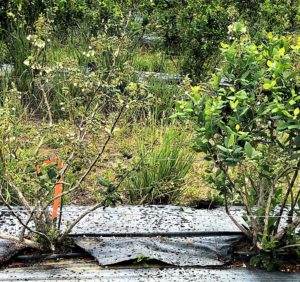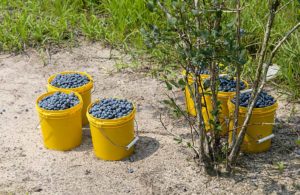—by Matt Milkovich

Fruit rots such as anthracnose and botrytis pose some of the biggest threats to blueberry fruit quality, and growers across the country need better tools to manage them.
Michigan State University plant pathologist Tim Miles leads a new, nationwide project to develop more effective fruit rot management tools for blueberries. The four-year project is funded by a $3.95 million grant from the U.S. Department of Agriculture’s National Institute of Food and Agriculture.
Though much is already known about fruit rot diseases, project researchers want to dig deeper. They want to learn how blueberry management practices might affect pathogen development, and how and when pathogens develop resistance to fungicides.
“Fruit rots are particularly frustrating, because fruit will often look good early in the season, but the berries will be infected internally and you won’t realize there’s an issue until harvest,” said University of Georgia fruit pathologist and project researcher Jonathan Oliver.
Fruit rots present a problem in nearly every blueberry growing region. Miles said Michigan growers spend about two-thirds of their fungicide costs on anthracnose management. A nationwide project enables different regions to share information and learn by communicating with each other as they manage rots in different ways.
One of Miles’ project goals is to create more accurate blueberry ripeness models. Michigan growers typically pick berries when they’re about 50 percent blue, but that’s based more on traditional practice than scientific findings. Is there a connection between the timing of berry ripening and fruit rot development? Would picking berries at a specific time lower the risks?
As part of the project, MSU agricultural engineer Yuzhen Lu will study imaging technology to detect fruit rots in sorting lines. Horticulturist Josh Vander Weide plans to develop more nuanced management strategies and more effective fungicide programs. Anthracnose and botrytis behave differently, and horticultural practices that impact one might not impact the other. Disease susceptibility varies by variety, too, Vander Weide said.

In New Jersey, Rutgers University plant pathologist Peter Oudemans will study the prevalence of pathogens in blueberry blossoms.
“People undervalue the role of flowers in disease cycles,” Oudemans said.
Washington State University plant pathologist Chakradhar Mattupalli is collecting botrytis isolates from blueberry fields in Western Washington, to better understand the prevalence of fungicide resistance in the region. He wants to develop a way to rapidly identify resistance to different fungicide chemistries, he said.
The root causes of fungicide resistance in fruit rot pathogens are not well understood. Through the project, researchers aim to gain a deeper understanding of fungicide resistance, down to the molecular level, Miles said.
In Georgia, Oliver wants to develop fruit rot management practices tailored to the state’s unique climate and varieties. Hotter and more humid than other U.S. blueberry regions, Georgia can develop major disease problems if management practices aren’t “tight,” he said.
“If you miss key management interventions early in the season, it might come back to bite you,” Oliver said.
Georgia grows different types of blueberries — rabbiteyes and southern highbush varieties, as opposed to the northern highbush varieties grown in other states. Georgia’s climate might harbor different fruit rot pathogens, too. That’s another subject Oliver wants to study further, he said.
The project’s final objective is to build a national database and website to share its findings, Miles said. •








Leave A Comment